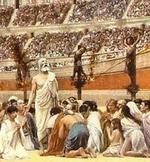Catholic Activity: Nativity of Mary
On September 8 the Church celebrates the feast of the Nativity of Mary. Father Weiser gives the historical background of the feast, and includes folklore attached to this day.
DIRECTIONS
A feast in honor of Mary's birth seems to have been held in Syria and Palestine in the sixth century. Saint Romanus (457), a native of Syria and later deacon of a church in Constantinople, was probably the first one who brought this feast to the attention of the authorities of the Greek Church. He wrote a hymn in honor of Mary's birth and spread the knowledge of this festival among the population of East Rome. His efforts were highly successful, for in the following centuries mention is made of a celebration of Mary's nativity in many churches of the empire. Saint Andrew of Crete (740), Archbishop, preached sermons in honor of the feast, as did Saint John Damascene.
This celebration was accepted and adopted by the Roman Church at the end of the seventh century. It spread very slowly through the rest of Europe. Saint Fulbert (1028), Bishop of Chartres, mentioned it in one of his sermons as a "recent" feast. By the twelfth century, however, it was observed among all Christian nations as one of the major feasts of Mary, and remained a holyday of obligation until 1918.
There is no historical evidence to indicate why the Nativity of Mary should fall precisely on September 8. As usual in such cases, legends of a later period supply the missing motivation by miraculous events. There is a lovely medieval legend giving the reason for the date: The feast was made September 8 because in the fifth century a pious farmer at Angers in France one night had a vision of angels singing in Heaven. When he inquired for the reason he was told that they were rejoicing because the Blessed Virgin was born that night. It happened to be September 8. So the good farmer went to the Bishop, Saint Maurilius (430), who, after convincing himself of the farmer's sincerity, established a feast in honor of the birth of Mary to be celebrated annually on that day.
Actually, of course, the festival did not originate in France but came from the Middle East. The real reason for the date is unknown. It is not improbable, though, that a genuine ancient tradition of the Church in Jerusalem provided the date, especially since the feast originated in Palestine; and all the Eastern Churches have celebrated Mary's nativity either on September 8 or 9 from the earliest times. The Syrians observe on this day also the solemn memory of the parents of Mary, Saint Joachim and Saint Anna.
In many places of central and eastern Europe the Feast of Mary's Nativity is traditionally connected with ancient thanksgiving customs and celebrations. The day itself marks the end of the summer in popular reckoning, the beginning of the Indian summer, which is called "after-summer" (Nachsommer), and the start of the fall planting season. A blessing of the harvest and of the seed grains for the winter crops is performed in many churches. The formula of this blessing may be found in the Roman Ritual.
In the wine-growing sections of France, September 8 is the day of the grape harvest festival. The owners of vineyards bring their best grapes to church to have them blessed, and afterward tie some of them to the hands of the statue of the Virgin. The Feast of Mary's Nativity is called "Our Lady of the Grape Harvest" in those sections, and a festive meal is held at which the first grapes of the new harvest are consumed.
In the Alps the "down-driving" (Abtrieb) begins on September 8. Cattle and sheep leave their summer pastures on the high mountain slopes where they have roamed for months, and descend in long caravans to the valleys to take up their winter quarters in the warm stables. The lead animals wear elaborate decorations of flowers and ribbons; the rest carry branches of evergreen between their horns and little bells around their necks. The shepherds and caretakers (Sennen) accompany the caravan, dressed in all their finery and decorated with Alpine flowers, singing their ancient songs, yodeling, and cracking whips to provoke a multiple echo from the surrounding mountain cliffs. Arriving at the bottom of the valley in the evening, they find the whole village or town awaiting them in a festive mood. Ample fodder is served to the cattle in the stables, and a banquet unites the family and farm hands in each house.
If, however, the farmer who owns the cattle or one of the Sennen has died during the summer, the "downdriving" is performed without decorations and in silence. Each animal then wears a mourning wreath of purple or black crepe. In some sections of Austria all the milk obtained on Drive-Down Day is given to the poor in honor of our Lady, together with the meat, bread, and pastries left over from the feast in the evening.
In central and northern Europe, according to ancient belief, September 8 is also the day on which the swallows leave for the sunny skies of the South. A popular children's rhyme in Austria contains the following lines:
It's Blessed Virgin's Birthday,LITURGICAL PRAYER: We pray Thee, O Lord, grant to Thy servants the gift of heavenly grace: as the childbearing of the blessed Virgin was the beginning of our salvation, so may the devout celebration of her Nativity accord us an increase of peace.
The swallows do depart;
Far to the South they fly away,
And sadness fills my heart.
But after snow and ice and rain
They will in March return again.
Activity Source: Holyday Book, The by Francis X. Weiser, S.J., Harcourt, Brace and Company, Inc., New York, 1956






